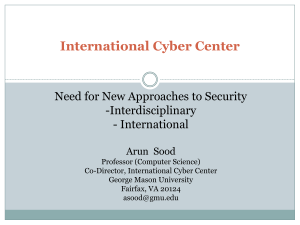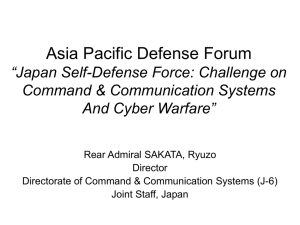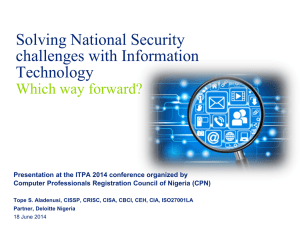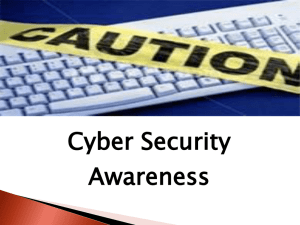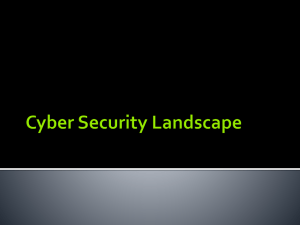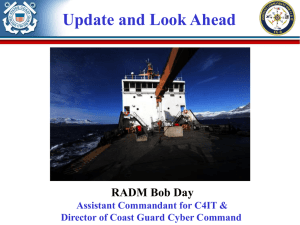ASEAN Regional Forum
advertisement
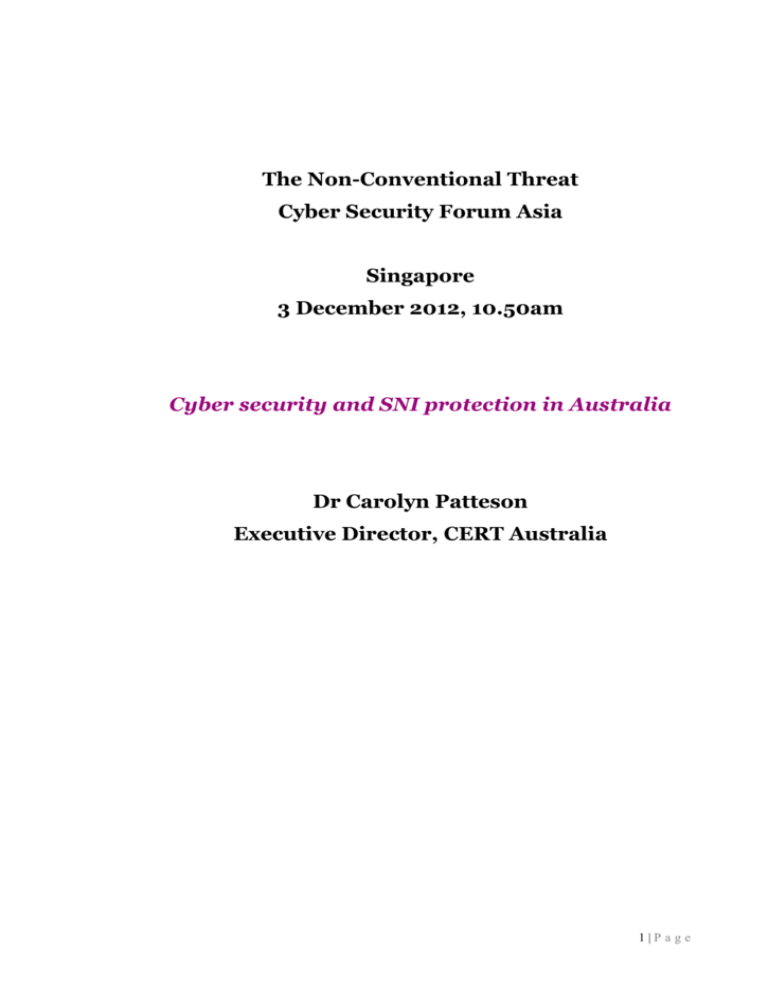
The Non-Conventional Threat Cyber Security Forum Asia Singapore 3 December 2012, 10.50am Cyber security and SNI protection in Australia Dr Carolyn Patteson Executive Director, CERT Australia 1|P age [Acknowledgements] Chair – Daniel Levy, Managing Director Asia, IB Consultancy Distinguished guests Ladies and gentlemen [Introduction] It’s an honour to join you for this conference – and to be presenting the keynote address. CERT Australia places great value on the partnerships we have with our colleagues in the Asian region. And it’s always a pleasure to provide you with an update on our latest activities in protecting Australia’s national interests online. [Cyber security in Australia] One of the things I was asked to cover is cyber security in Australia. 2|P age And as I was thinking about our evolution, I realised that over the last few years, we have come a long way. But I would also suggest that we are still learning – especially about business-government partnerships and how we can really make the most of them. So it was four years ago, almost to the day, that the then Prime Minister delivered Australia’s inaugural National Security Statement. And while government agencies already had cyber security responsibilities, the statement marked an important shift – a line in the sand, if you like – by publicly acknowledging that cyber security is a national priority. The statement included these words ... … The sophistication of our modern community is a source of vulnerability in itself … … This dependency on information technology makes us potentially vulnerable to cyber attacks that may disrupt the information that increasingly lubricates our economy and system of government. This acknowledgement then kicked off a whole-ofgovernment response to cyber security – in terms of both policy and action. 3|P age It brought together things we were already doing in the government space, with a new focus on the importance of protecting our corporate networks as well. The emphasis on cyber security and cyber operations came out in two key documents – the 2009 Defence White Paper and Cyber Security Strategy. The Defence White Paper affirmed the Government’s commitment to the defence of Australia, as well as the security and stability of the region. It stated … … In the past decade the growing importance of operations in cyberspace has become more apparent. Our national security could potentially be compromised by cyber attacks … … Therefore, we must focus on developing capabilities that allow us to gain an edge in the cyberspace domain … … And the Cyber Security Strategy aimed to promote cyber security and resilience – and protect Australian assets from cyber threats, which had been and still are, assessed as high. The practicalities of making this happen involve a range of Government agencies. 4|P age In sum the Department of the Prime Minister and Cabinet is responsible for cyber security policy the Australian Security Intelligence Organisation – ASIO – focuses on cyber espionage the Defence Signals Directorate – DSD – looks after protecting government agencies the Australian Federal Police – AFP – looks after cyber crime the Department of Broadband looks after cyber safety, especially through the Stay Smart Online website, and the Australian Communications and Media Authority looks after SCAMwatch. In addition, and integral to delivering the Cyber Security Strategy, are two mutually supporting organisations – the Cyber Security Operations Centre – the CSOC – and CERT Australia. CERT Australia is located in the Attorney-General’s Department and our focus is on protecting critical businesses and Australia’s national interests online. 5|P age The CSOC is located in the Department of Defence and incorporates staff from ASIO, DSD, CERT Australia and the AFP. Importantly, it enables the operational agencies to work closely together, sharing information and protecting government and critical business networks. This of course, is a very simple breakdown of who’s who in Australian cyber security – and what we do. As I’m sure you can appreciate, in practice it is a tad more complex. But having generally set the scene, I’ll now talk more about the work of CERT Australia. [CERT Australia] We were established in 2010. We operate from Canberra and Brisbane, and work in the CSOC with other key agencies including ASIO, the AFP and DSD. 6|P age Essentially, we provide big business with information about cyber threats, and support in responding to cyber security incidents. By ‘big business’ I refer to critical sectors of the Australian economy such as communications, banking and finance, water and energy. The term ‘systems of national interest’ refers to the super set of this critical infrastructure. If these systems were rendered unavailable or otherwise compromised, it could cause major harm to Australia’s economic prosperity, national defence and security. In CERT Australia, we work very much on a trust basis and have established partnerships with approximately 500 private sector organisations. We run a 24/7 incident response capability to help businesses, and to coordinate larger or upstream responses in the event of serious cyber attacks. We’re not a substitute for internal or commercial security teams but rather, we help them on difficult or unbounded issues that need a greater degree of response. As the national CERT, we are the initial point of contact for cyber security incidents impacting Australian networks. 7|P age We are responsible for making connections between sectors – which are integrally linked. And we are the voice of reason. If media reports distort the accuracy of a cyber security situation – CERT Australia reports the facts. A good example from earlier this year was the Flame virus. It received quite a bit of media hype. But in reality – there have been no reports of Flame infections in Australia. The malware does not self-propagate. And most anti-virus products have been updated to detect it. This was the official advice issued by CERT Australia. Having said that, are we perfect? No. But we have proved the value we add in helping protect Australia’s national interests online. 8|P age We are continually learning lessons and improving our systems and processes. And one of our key strengths is the relationship we have with other government agencies and industry. [Partnerships] As Australia’s national CERT, we are at the centre of government engagement with business on cyber security. We know that developing effective partnerships – close working relationships – is vital to countering cyber attacks and boosting cyber resilience. Of course, partnerships at the international level are also vital to combatting cyber threats. And we have close working relationships with our international counterparts too. This national and international teamwork is essential to providing business with timely information on emerging threats – and advice on mitigation. As we all know, cyber crime is rapidly evolving. 9|P age It is a constant challenge. And cyber criminals are relentless in their pursuits to disrupt business systems and operations. Because of the range and pervasive nature of cyber threats, no single organisation or country, can adequately recognise and counter them. That’s why cyber security requires a partnership approach, nationally and internationally. This is a fight we are definitely in together. And it’s by working together that we will be better positioned for prevention and response. One of the most important aspects of a partnership approach is sharing information. This helps increase our respective and combined understanding and awareness of cyber security threats. Just recently, in September, some of my CERT Australia colleagues and I came to Singapore, to co-chair the ASEAN Regional Forum Cyber Incident Response Workshop. 10 | P a g e It was well attended by representatives from around the region, who were presented with a range of evolving scenarios. One of the top observations that we all shared was the importance of effective working relationships – as well as access to timely, high quality information. [Threats] So what are the cyber threats we face? Well, in Australia we’re experiencing increasingly sophisticated attacks on networks and systems in both the public and private sectors. Our security and intelligence agencies are now stating this publicly. And a significant amount of attacks against Australian organisations appear to be economically motivated. Some recent research estimates that for a large organisation, the average cost is as much as $3.2 million per year.1 1 October 2012 – research by Ponemon Institute – case studies with 33 Australian large companies 11 | P a g e The threats come from a range of sources including individuals, issue-motivated groups, organised criminal syndicates and the intelligence services of some foreign governments. So far this year, CERT Australia has had more than 5,000 incidents reported to us. Although perhaps a scarily high number, many of these incidents are scans of firewalls or website defacements. But at the higher end, we are seeing broad-based and targeted attacks, as well as everything in between. In broad-based attacks, the offenders send out a lot of wellknown generic attempts – a scatter approach if you like. This is very cheap – but the return rate can be very low. Some of these attacks can also be quite naïve – but just because they appear simple, doesn’t mean they don’t work. For example, the Nigerian money scam has translated well from the paper world to the electronic one. To most of us it’s obvious – but some people still fall for it. 12 | P a g e Broad-based attacks can also include denials-of-service, although we do see those targeted at particular sectors as well. As for sophisticated attacks, offenders send out a small number of highly targeted and often very novel attempts to compromise their intended victims. We frequently see very carefully crafted emails that are designed to get someone to open them. This way the attacker can gain a foothold on the network undetected, and then snoop around to extract valuable company or client information. A lot of these attacks are directed at senior managers and their staff – because they’re the people who are likely to have high levels of access to sensitive corporate and operational information. We’re also seeing trends in cyber incidents which show that specific sectors can be targeted – rather than just individual companies – depending on the type of activity. This includes distributed denial-of-service – or DDoS – attacks being used for extortion purposes. 13 | P a g e Just recently, we’ve seen emails purporting to be from the CEO going to the CFO asking for details of company finances. Of course, the email isn’t from the CEO and fortunately this is fairly easy to spot. But we have seen this form of attack targeting a particular sector. Earlier this year we received reports from a range of Australian financial businesses that were being targeted by denial-of-service attacks. The companies had been called and threatened with an attack against their websites unless a payment was made. This type of attack can cause serious problems. It can not only disrupt the companies’ online activities via their websites, it can also stop clients from doing business with them online. Recently, we’ve also encountered a number of particular malware attacks, which make for an interesting case study. 14 | P a g e [Case study] In late September, we received a series of calls from more than 25 organisations being targeted by ransomware. The attacks encrypted files on the compromised system and/or locked the victim out of the desktop environment. The attacks also encrypted files in the system backups. The victims were then asked by the attacker to pay a fine using a payment or money transfer service, to obtain the codes that would unlock the computer and/or decrypt the data. In some cases, the ransomware included scareware, displaying a fake warning screen, claiming that the victim’s computer had been associated with criminal activity. This was a tactic to discourage the victim from reporting the attacks to law enforcement agencies or CERT Australia. For example, one warning screen was set up to look like it was from the Anti Cyber Crime Department of the Federal Internet Security Agency. There is no such agency. 15 | P a g e In the majority of cases, the attackers used Microsoft Remote Desktop Protocol as an entry point to the target network. This was possibly using authentication credentials obtained by key loggers, or accessing systems with weak credentials. The severity of the damage done by the attacks varied across the target organisations. In the worst case scenario reported to us, one victim lost 15 years’ worth of critical business data. That’s a serious compromise. To provide some insight into how we work on these types of issues, here’s a rundown of the actions we took. Firstly, we worked directly with the affected organisation to help it better defend against the attack. Where the organisation had outsourced management of its website, we worked with the service provider to help them take steps to protect the affected network. We worked with law enforcement locally because of the criminal nature of the activity. 16 | P a g e We also worked with Microsoft – sharing data and analysis. And we contacted our international CERT colleagues, as the threat actors used infrastructure based overseas. Unfortunately, as yet the actors have not been found. They have been meticulous in hiding their tracks. At this point, I’d like to note that the focus of CERT Australia is on helping business detect and then respond to attacks. It’s not about tracing the attacker. Attribution is really difficult. Where you think something comes from may not be where it actually comes from. So, with the ransomware attacks, in addition to working with the affected organisations, we also started to identify others in Australia that had not yet reported the activity. We contacted these organisations to warn them that the attacks were happening in their sector. And we gave them advice about how to protect themselves. 17 | P a g e We also issued a guidance paper on the ransomware threat, which we made publicly available on our website. This case study highlights well the nature of CERT Australia’s mission – it’s all about helping business best prepare for and respond to cyber attacks. We use our government, industry and international partnerships to provide the most useful advice we can – as soon as we can. [Lessons Learnt] So what lessons can we learn from the ransomware incidents? Well, it definitely reinforced the need for us to be communicating with the law enforcement community. These types of incidents tend to be reported to a range of different organisations and agencies. In Australia, we have federal government agencies, and law enforcement agencies. We also have state and territory government agencies, and law enforcement agencies. 18 | P a g e The organisations affected by these types of incidents can contact one or more of these agencies. We’ve found it’s only by communicating with others that we can gain a clear understanding of the extent of the problem, and also develop a consistent approach to dealing with the problem. This is one of the primary roles and strengths of a national CERT. We need to be the organisation that has contacts with many others. And we need to be the organisation that those who are affected by cyber attacks feel comfortable talking to, and seeking help from. Sometimes it won’t be our role to help. But we’re in a perfect position because of our contacts, to know who can help. We’re also finding that organisations are becoming more aware and are getting better at protecting their systems. This is something we consistently encourage and promote. 19 | P a g e It’s important for an organisation to know its network, understand the value of its information, and how it’s protected. This includes understanding enough to work out how an attack got onto the network what data may have been accessed, and what needs to be done to increase the protections of the network. We also encourage critical businesses to partner with us before they actually need us because of an incident. By partnering with us – we can keep them informed about potential threats – as well as assisting them with detection and mitigation. This leads me to talk in more general terms about lessons learnt. And I’d like to address expectation management. It’s all very well to set up partnerships – but are the roles of each party clearly understood? 20 | P a g e For example, we find that some organisations expect us to be their dedicated CERT. We aren’t. And we won’t be. This means we need to clearly and consistently make sure our role is communicated and understood. As the national CERT, we have a niche. We’re able to provide information that is not available in the public domain. And we’re able to look for patterns or trends that a single organisation may not see. Basically, it takes time to get to know who’s who. And it takes experience to build trust as a two-way street. The fact is, that business-government partnerships are hard. They take constant work. But – they are worth it. 21 | P a g e [Cyber Crime and Security Survey] So having talked about threat, and the criticality of business-government partnerships, I’d now like to focus on what we don’t know. At the moment in Australia, we know there is a growing impact of cyber crime and security incidents. But the true extent of these evolving threats is difficult to determine. That’s why we recently conducted the Cyber Crime and Security Survey, in collaboration with the Centre for Internet Safety at the University of Canberra. The survey was designed to help build a better picture of how cyber incidents affect Australian business and our economy. While international reports and experiences are informative, they don’t necessarily provide a clear picture of what’s happening in Australia. To ensure we had a representative sample, more than 450 organisations that work with us were contacted. Analysis of the data is underway and the final report is due soon. 22 | P a g e Meanwhile, we do have some preliminary results. Around 60 per cent of organisations contacted responded to the survey. This is a great response rate and reflects the trusted relationships we have with our business partners. Initial results also show that more than 90 per cent of respondents deployed firewalls, anti-spam filters and anti-virus software two-thirds of respondents leveraged IT security related standards more than 20 per cent of respondents were aware they had experienced a cyber incident in the last year, and more than 50 per cent of respondents have increased their expenditure on IT security in the last year. It will be very interesting to see the final report and get a better picture of our cyber threat environment. [Conclusion] To recap though, this is what we currently know for sure. 23 | P a g e So far this year we’ve had more than 5,000 incidents reported to CERT Australia. Most of them are what we categorise as less severe. But we do see more serious incidents too, including cyber crime and state sponsored activities. This is a good reminder that while some actors are hacking for fun, there are others with much more sinister motives. It’s now publicly acknowledged in Australia that cyber operations is one of the most rapidly evolving threats to our national security. So what do we predict for the future? In sum – we predict more. More players, more tools, and more attacks. This is not cause for panic. It is cause for concern. It’s why we must have strong business-government partnerships. 24 | P a g e It’s why we must have strong international partnerships. And it’s why we must keep sharing important information in regional forums such as this. Thank you. 25 | P a g e
